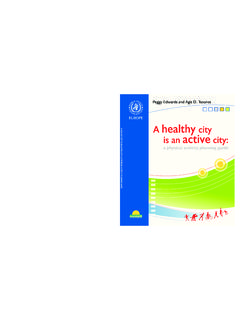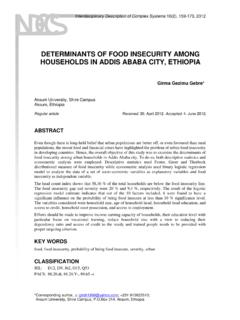Transcription of Planning and Health Resource Guide for Designing and ...
1 Planning and Health Resource Guide for Designing and building healthy NeighborhoodsNational Center for Environmental HealthDivision of Emergency and Environmental Health ServicesCS241355 AIntroductionThe way we design and build our neighborhoods can affect our physical and mental Health . In this time of rising obesity rates, traffic congestion, long work hours, high stress levels, and fewer opportunities to be physical active, finding creative ways to address these issues is important. We must also consider the changing weather patterns and the possible impact on our way of life. All these factors stress the importance of Designing and building healthy and vital communities that promote Health . To learn more about healthy community design, watch the Centers for Disease Control and Prevention s (CDC), 15-minute video building healthy Communities at You may also find helpful CDC s healthy Community Design fact sheet available at About the Resource GuideThis Resource Guide provides links to guides, checklists, audit tools, Web sites, and pamphlets that can help planners, local officials, and local citizens create vibrant neighborhoods where the healthy choice is the easy choice.
2 The Guide is structured to complement CDC s healthy Community Design Checklist ( ), including resources for each of the Checklist s seven categories. The Resource Guide is a small sample of the many excellent resources available that address healthy community design. Comprehensive GuidesNYC s Active Design Guidelines NYC Dept. of Health and Mental Hygiene Built Environment and Physical Activity Program worked in partnership with the American Institute of Architects and other city departments including the Departments of Transportation, Design and Construction, and City Planning to develop NYC s Active Design Guidelines ( ). healthy , Active & Vibrant Community Toolkit The toolkit is a Resource to provide key community decision-makers with innovative ideas, policy suggestions and healthy community and living resources for improving the Health of their communities.
3 For healthy Communities Action Strategies Toolkit The toolkit addresses the childhood obesity epidemic in the , especially the increased risk faced by racial and ethnic minorities. Comprehensive strategies on how the built environment influences active living and healthy eating are provided. South Wales Department of Health healthy Urban Development Checklist The checklist, developed by the Government of New South Wales, Australia, provides evaluation questions that include housing, public open space, and social cohesion, to measure the Health impacts of various development plans and policies. Impact Assessment: A Guide for Practice The Guide is for local officials and others to conduct Health Impact Assessments in their communities, laying out the basic steps and strategies used in the process.
4 By Category (See CDC s healthy Community Design Checklist) I want more options to help me get outside and be more activeProviding features such as parks, bike trails, rec centers, and outdoor plazas that give people a place to be active encourages outdoor physical activity. Ensuring that sidewalks are in good repair and streets are safe for people who walk and bike are important, too. The following guides offer strategies for creating features that encourage people to spending more time outside and living active lives. Active neighborhood ChecklistThis do-it-yourself checklist addresses street-level features of neighborhood environments relating to physical Park Audit Guideline and ToolThis Guide allows users to audit neighborhood parks for design criteria related to physical activity. The tool itself is Guideline: : Active Community Environments Resource Kit to Prevent Obesity and Related Chronic Diseases This Guide offers advice on creating an active-friendly environment where it is easy to be physically active on a routine basis.
5 The Guide also includes an Active Community Environments checklist for assessing communities ( ) and a sample resident survey (p. 42-48). I want to have healthier and more affordable food choicesJust hearing about the benefits of a balanced diet persuades some people to change their eating habits and lifestyles. For others, eating a healthy diet may be more difficult because healthy food options are not readily available, easily accessible, or affordable near their homes. These guides offer tools and strategies to help increase access to healthy foods through the promotion of farm to fork campaigns, farmers markets, community gardens, urban agriculture, the equitable place-ment of grocery retailers, and healthy corner Policy Guide on Community and Regional Food PlanningThis American Planning Association (APA) policy Guide offers seven general policy recommendations regarding urban and regional food Planning , with specific roles for Food Access Policy and Planning Guide This guidebook offers advice and provides examples of model language for policies that address issues of healthy retail, farmers markets, urban agriculture, restaurants, and transportation.
6 It also includes a quick reference Food Ac-cess Menu with key steps to follow (pp. 10-11). Food Security Assessment ToolkitThe Department of Agriculture toolkit offers guidance on conducting community food security assessments to ensure that all residents have access to enough food for an active, healthy life. The toolkit includes tools for assem-bling community assessment teams, conducting focus groups and surveys and collecting the necessary data for the Access to healthy Food: A Community Planning ToolThe tool offers strategies on developing a healthy food action plan, implementing it, and evaluating its Food checklist provides steps people can take to promote a healthier food environment in their I want to get around in my community more easily without a carWalking, biking and other active modes of transport are great ways to fit exercise into busy daily routines.
7 They also allow us to get outdoors, interact more with our neighbors, and help reduce traffic emissions. These resources offer advice on how to make neighborhoods safer for people who walk, bike, and take public transit. Bikeability ChecklistThis checklist provides an easy-to-conduct audit that scores a neighborhood s bikeability based on a number of design Checklist Similar to the Bikeability Checklist, this tool evaluates a neighborhood s design for walking and produces a walkability County Model Design Manual for Living StreetsThe manual, developed by Los Angeles County, provides principles of good street design as well as concept drawings that promote active, living streets. The manual focuses on issues related to walking and bike access, traffic calming, intersection design, and land use along streets.
8 Corridors, Great CommunitiesThe Guide highlights eight successful corridor Planning projects that considered multiple forms of transportation. De-tailed case studies illustrate the tools used to make the projects a success. a Road Map for Producing & Implementing a Bicycle Master PlanThe Guide provides steps and strategies for the initial Planning , development and implementation of a bike master I want to feel safer in my community Feeling safe in our surroundings plays a big role in the state of our mental Health , social interaction and our physical activity levels. The following tools and guides offer ways to evaluate a locale for crime or danger, and offer strategies for creating safer places to Resource GuidelineThe Guide explains CPTED (Crime Prevention Through Environmental Design), offers tips on how to apply CPTED in various situations, provides templates to follow and links to other resources, including those tailored to specific safety Crime Prevention Council of Singapore CPTED GuidebookThis guidebook, which draws from several CPTED manuals, provides guidance on safety design measures by spe-cific location type such as schools, downtowns, and shopping districts.
9 It also includes a checklist of Yes/No questions to assess a location s of Edmonton Safety Audit GuideCreated by the Safer Cities Initiative Office in Edmonton, Canada, the Guide provides a checklist of safety audit ques-tions; and detailed advice on how to organize, conduct, and follow-up on a safety audit. The Guide also offers tips on conducting large, joint, and transit safety audits. Safety Audit ChecklistThis safety audit checklist from the Local Initiatives Support Coalition (LISC), offers a quick-reference tool to conduct safety audits for any I want to have more chances to get to know my neighbors A friendly neighborhood is a healthy neighborhood . We need to feel comfortable walking around and talking with our neigh-bors. This allows us to build a sense of safety and trust and helps create a neighborhood that is relaxing, enjoyable, friendly and welcoming.
10 Public places, such as parks and plazas, are great places for neighbors to Neighboring Resource Guides The one-page Good Neighboring Guide offers simple tips on how to create a friendly and welcoming environment through social activities and fostering neighbor Good Neighboring pamphlet gives 8 strategies for becoming better neighbors such as welcoming a new neigh-bor, motivating people, and creating partnerships with a local business. ( ).( )The Community ToolboxThis chapter of the toolbox explains the importance of creating neighborhood action activities that bring neighbors in contact with one another, or helps them appreciate their neighborhood more; and offers strategies and tips on when and how to promote neighborhood action. Links to additional resources with more in-depth guidance are also provided.
















